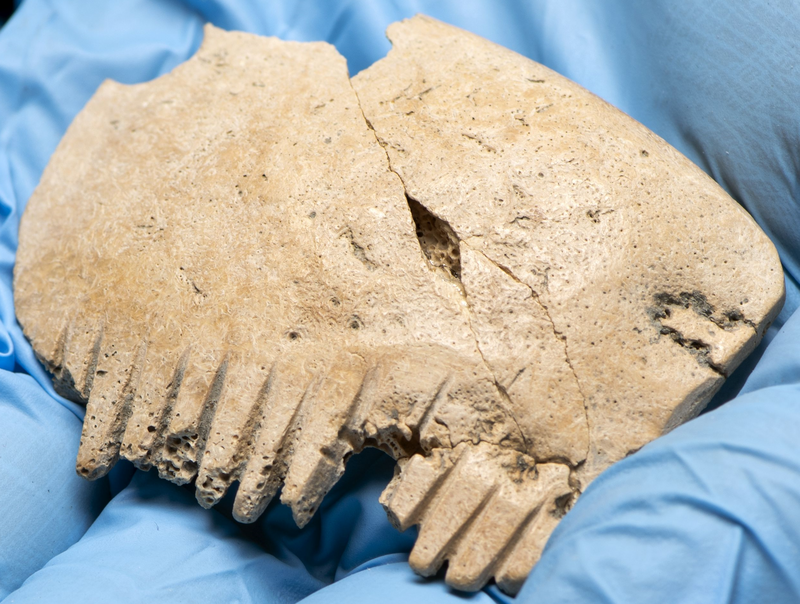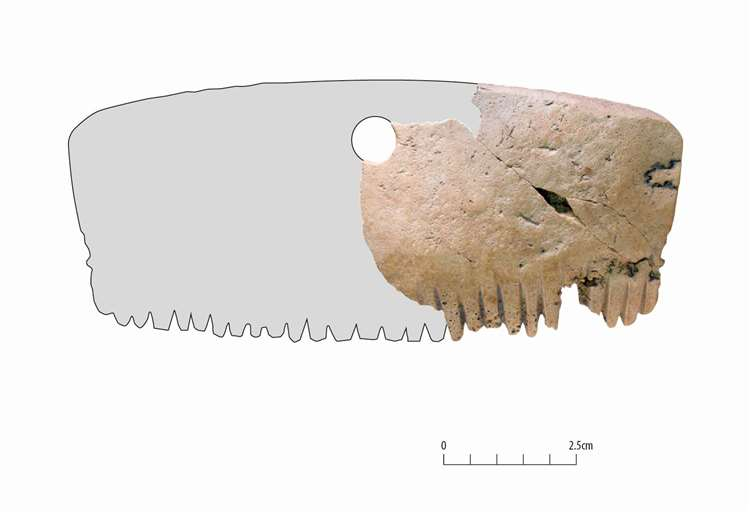Archaeologists discovered the comb at an Iron Age site in Bar Hill. Only two other examples of human bone combs have ever been found – both within 15 miles of the site.
An ancient comb carved from a human skull has been discovered and it reveals an Iron Age practice thought to be unique to Cambridgeshire.
Archaeologists discovered the comb at an Iron Age site in Bar Hill. Only two other examples of human bone combs have ever been found – both within 15 miles of the site.

Image
The Bar Hill Comb is a glimpse of a hyper-local tradition from more than 2,000 years ago.
The comb was identified by archaeologists at the Museum of London Archaeology (MOLA) during analysis of more than 280,000 artefacts recovered by MOLA-Headland Infrastructure (MHI) as part of archaeological excavations on National Highways’ A14 Cambridge to Huntingdon upgrade, between 2016 and 2018.

Image
Dating to the Iron Age (750 BC-43 AD), it takes the shape and form of a comb, although its exact use is only a theory. But the rare artefact does illuminate ritual and belief in Iron Age Britain.
Reuse of human bone seems to have been relatively common in Iron Age Britain, with objects used in rituals relating to the dead and in everyday life. Other archaeological excavations in Cambridgeshire have uncovered tools for cleaning animal skins made from human leg and arm bones.
Combs from animal bone were equally common and were used for textile work as well as styling hair, but human bone combs have not been found outside the county.

Image
MOLA finds team lead Michael Marshall said: “It is possible this fascinating find represents a tradition carried out by Iron Age communities living solely in this area of Cambridgeshire. To be able to see such hyper-local influences in groups of people living over 2,000 years ago is truly astonishing.”
With no evidence of wear on the comb’s teeth, it is not thought to have been used as a functional item. Michael noted that a circular hole drilled into the comb suggests it may have been worn as an amulet.
There are many examples of pieces of human skull thought to have been worn as amulets.

Image
Michael explained: “The Bar Hill Comb may have been a highly symbolic and powerful object for members of the local community. It is possible it was carved from the skull of an important member of Iron Age society, whose presence was in some way preserved and commemorated through their bones.”
Further analysis on the two similar pieces of worked human skull from Cambridgeshire have prompted another theory.
The first example, unearthed at Earith in the 1970s, featured carved teeth, while the second, found during excavations at Harston Mill in the early 2000s, only featured incised lines.
Michael suggested that if these objects were not meant for use as combs, perhaps the carvings represent the natural sutures that join sections of the human skull: “These carved teeth and lines would have emphasised the Bar Hill Comb’s origin, at least amongst communities familiar with skeletal remains – as many in the Iron Age would have been.”

Image
The Bar Hill Comb will be kept at the Cambridgeshire Archaeology Archive, the main repository for material found as part of archaeological fieldwork in the county.
Previously, the remains of a woolly mammoth dating back to the Ice Age were found during the A14 upgrade scheme.
Related Post
A shocking documentary proves that mermaids do exist
SHOCKING Revelation: Thuya, Mother of Queen Tiye, Was the Grandmother of Akhenaten and Tutankhamun—What Ancient Egyptian Secrets Did She Leave Behind?
Breaking News: Astonishing Discoveries at Karahan Tepe Confirm an Extraterrestrial Civilization is Hiding on Earth, and NO ONE Knows!
Breaking News: Researchers FINALLY Discover U.S. Navy Flight 19 After 75 Years Lost in the Bermuda Triangle!
NASA’s Secret Investigation: Uncovering the Astonishing Mystery of the UFO Crash on the Mountain!
Explosive UFO Docs LEAKED: Startling Proof That Aliens Ruled Ancient Egypt!